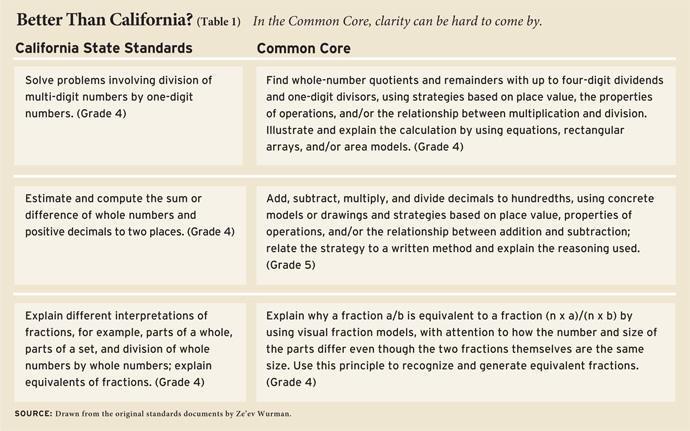Education Next talks with Ze’ev Wurman and W. Stephen Wilson
 More than 40 states have now signed onto the Common Core standards in English language arts and math, which have been both celebrated as a tremendous advance and criticized as misguided and for bearing the heavy thumbprint of the federal government. Assessing the merits of the Common Core math standards are Ze’ev Wurman and W. Stephen Wilson. Wurman, who was a U.S. Department of Education official under George W. Bush, is coauthor with Sandra Stotsky of “Common Core’s Standards Still Don’t Make the Grade” (Pioneer Institute, 2010). Wilson is a professor of mathematics at Johns Hopkins University, served on the National Governors Association-Council of Chief State School Officers “feedback group” for the Common Core standards, and was mathematics author of Stars by which to Navigate? Scanning National and International Education Standards in 2009: An Interim Report on Common Core, NAEP, TIMSS, and PISA.
More than 40 states have now signed onto the Common Core standards in English language arts and math, which have been both celebrated as a tremendous advance and criticized as misguided and for bearing the heavy thumbprint of the federal government. Assessing the merits of the Common Core math standards are Ze’ev Wurman and W. Stephen Wilson. Wurman, who was a U.S. Department of Education official under George W. Bush, is coauthor with Sandra Stotsky of “Common Core’s Standards Still Don’t Make the Grade” (Pioneer Institute, 2010). Wilson is a professor of mathematics at Johns Hopkins University, served on the National Governors Association-Council of Chief State School Officers “feedback group” for the Common Core standards, and was mathematics author of Stars by which to Navigate? Scanning National and International Education Standards in 2009: An Interim Report on Common Core, NAEP, TIMSS, and PISA.
Education Next: Are the Common Core math standards “fewer, higher, and clearer” than most state standards today? Can you provide some specific examples where you think the Common Core marks a step forward or backward?
Ze’ev Wurman: Common Core standards may in fact be clearer and more demanding than many, though not all, of the state standards they replaced. The Fordham Institute reviewed them last year and found them so. While I have no reason to doubt the technical quality of that review, there is good cause to note what it does not say.

It does not say that Common Core standards are fewer. Indeed, if one compares them to the better state mathematics standards like those of Minnesota or California, they are more numerous. Minnesota’s standards fill 42 pages and California’s 59 pages, while the Common Core takes 73 pages even without the advanced statistics or calculus sections that are included in California’s standards. Counting the standards rather than pages, in grades 1 to 4 California has, on average, a few more standards than Common Core, but in grades 5‒8 the Common Core standards are more numerous than California’s.
Fordham’s review does not unequivocally say the standards are higher, either. They may be higher than some state standards but they are certainly lower than the best of them. For example, the 2008 report of the National Mathematics Advisory Panel, Foundations for Success, called for fluency in addition and subtraction of whole numbers by the end of grade 3, and fluency in multiplication and division by the end of grade 5. This is also what California calls for, along with high achievers like Singapore and Korea. (Japan and Hong Kong finish with multiplication and division of whole numbers even earlier, by grade 4.) Yet the Common Core defers fluency in division to grade 6. Fractions are touted as the Common Core’s greatest strength, yet the Common Core pushes teaching division of fractions to grade 6 without ever expecting students to master working with a mix of fractions and decimals. Students in Singapore, Japan, Korea, and Hong Kong achieve fluency in fractions and decimals in grade 5.
Nor are the Common Core standards necessarily clearer. They may be clearer than many state mathematics standards, but they still tend to be wordy and hard to read. Table 1 compares a few grade 4 California standards with their Common Core counterparts.
Andrew Porter, dean of the University of Pennsylvania’s Graduate School of Education, recently evaluated the Common Core standards with his colleagues, and their conclusion was stark:
Those who hope that the Common Core standards represent greater focus for U.S. education will be disappointed by our answers. Only one of our criteria for measuring focus found that the Common Core standards are more focused than current state standards…Some state standards are much more focused and some much less focused than is the Common Core, and this is true for both subjects.
We also used international benchmarking to judge the quality of the Common Core standards, and the results are surprising both for mathematics and for [ELA].… High-performing countries’ emphasis on “perform procedures” runs counter to the widespread call in the United States for a greater emphasis on higher-order cognitive demand.
Another recent analysis, by University of Southern California professor Morgan Polikoff, found the Common Core mathematics standards similarly repetitive, and hence as unfocused across elementary grades as the state content standards they attempt to replace, with only somewhat less redundancy in the middle grades.
In summary, analyses of the Common Core standards find them to be mediocre and not obviously better than many sets of state standards.

W. Stephen Wilson: It turns out that nearly everyone was in favor of Common Core standards in mathematics if, and this is a big if, they got to write them. As it turns out, no one got to write the standards. A committee wrote them. Worse, the committee was hired by the very states whose standards would be replaced, so states got first crack at suggesting “corrections” to the standards. The pressures on the writing committee must have been enormous. The only reasonable expectation was that the result would resemble some sort of middle way between the states’ various standards. What is surprising is that the standards don’t rank in terms of quality in the middle 20 percent of state standards, but, instead, fall in the top 20 percent.
There is much to criticize about them, and there are several sets of standards, including those in California, the District of Columbia, Florida, Indiana, and Washington, that are clearly better. Yet Common Core is vastly superior—not just a little bit better, but vastly superior—to the standards in more than 30 states.
Where this gap is most obvious, and most important, is in laying the foundation for college readiness in mathematics early, by grade 6 or 7. Judging by state standards, few people see a connection between elementary school mathematics and college math, let alone really understand how the foundation is built.
Arithmetic is the foundation. Arithmetic has to be a priority, and it has to be done right. A number of things can and do go wrong with state standards for arithmetic in elementary school.
With the introduction of calculators, many states have downplayed the importance of arithmetic, apparently not realizing its true educational value. Instead, they spend time on statistics and probability, both of which Common Core has tossed out of early elementary school. Another thing that states love is geometric slides, turns, and flips, sometimes presented every year in grades K‒11, perhaps under the mistaken belief that they are really doing mathematics.
Fewer than 15 states are explicit about the need for students to know the single-digit number facts (think multiplication tables) to the point of instant recall. States love to have kids figure out many ways to add, subtract, multiply, and divide, but often leave off the capstone standard of fluency with the standard algorithms (traditional step-by-step procedures for the addition, subtraction, multiplication, and division of whole numbers). For example, only seven states expect students to know explicitly the standard algorithm for whole number multiplication. Fractions are even harder to find done well. Standards for fractions are generally so vague that nearly everything is left to the reader. Often states expect students to develop their own strategies or a variety of strategies for dealing with fractions. For example, only 15 states mention common denominators. Common Core does a pretty good job with arithmetic, even a very good job with fractions.
EN: Will the Common Core put an end to what has sometimes been termed the “math wars”? In your view, do the math standards resemble those recommended by the National Council of Teachers of Mathematics (NCTM), and what do you make of that similarity (or lack thereof)?
WSW: The end of the math wars! You must be joking.
There will always be people who think that calculators work just fine and there is no need to teach much arithmetic, thus making career decisions for 4th graders that the students should make for themselves in college. Downplaying the development of pencil and paper number sense might work for future shoppers, but doesn’t work for students headed for Science, Technology, Engineering, and Mathematics (STEM) fields.
There will always be the anti-memorization crowd who think that learning the multiplication facts to the point of instant recall is bad for a student, perhaps believing that it means students can no longer understand them. Of course this permanently slows students down, plus it requires students to think about 3rd-grade mathematics when they are trying to solve a college-level problem.
There will always be the standard algorithm deniers, the first line of defense for those who are anti-standard algorithms being just deny they exist. Some seem to believe it is easier to teach “high-level critical thinking” than it is to teach the standard algorithms with understanding. The standard algorithms for adding, subtracting, multiplying, and dividing whole numbers are the only rich, powerful, beautiful theorems you can teach elementary school kids, and to deny kids these theorems is to leave kids unprepared. Avoiding hard mathematics with young students does not prepare them for hard mathematics when they are older.
There will always be people who believe that you do not understand mathematics if you cannot write a coherent essay about how you solved a problem, thus driving future STEM students away from mathematics at an early age. A fairness doctrine would require English language arts (ELA) students to write essays about the standard algorithms, thus also driving students away from ELA at an early age. The ability to communicate is NOT essential to understanding mathematics.
There will always be people who think that you must be able to solve problems in multiple ways. This is probably similar to thinking that it is important to teach creativity in mathematics in elementary school, as if such a thing were possible. Forget creativity; the truly rare student is the one who can solve straightforward problems in a straightforward way.
There will always be people who think that statistics and probability are more important than arithmetic and algebra, despite the fact that you can’t do statistics and probability without arithmetic and algebra and that you will never see a question about statistics or probability on a college placement exam, thus making statistics and probability irrelevant for college preparation.
There will always be people who think that teaching kids to “think like a mathematician,” whether they have met a mathematician or not, can be done independently of content. At present, it seems that the majority of people in power think the three pages of Mathematical Practices in Common Core, which they sometimes think is the “real” mathematics, are more important than the 75 pages of content standards, which they sometimes refer to as the “rote” mathematics. They are wrong. You learn Mathematical Practices just like the name implies; you practice mathematics with content.
There will always be people who think that teaching kids about geometric slides, flips, and turns is just as important as teaching them arithmetic. It isn’t. Ask any college math teacher.
The end of the math wars! You must be joking.
ZW: Math wars erupted as a result of the unfocused and mostly math-less 1989 NCTM standards. NCTM rewrote those terrible standards in 2000, yet much of what mathematicians found objectionable remained in place. Only in 2005, with the publication in Notices of the AMS [American Mathematical Society] of “Reaching for Common Ground in K–12 Mathematics Education,” did the two sides make a serious attempt to bridge the chasm. NCTM followed shortly with its 2006 Curriculum Focal Points, a document that finally focused on what mathematics is all about: mathematics. Since then, NCTM seems to have regressed, as evidenced by its 2009 publication Focus in High School Mathematics, a document that is full of high-minded prose yet contains little rigor or specificity.
The Common Core mathematics standards are grade-by-grade‒specific and hence are more detailed than the NCTM 2000 standards, but they do resemble them in setting their sights lower than our international competitors, by, for example, locking algebra into the high school curriculum.
And they contain inexplicable holes even when compared to the much shorter NCTM Curriculum Focal Points, the major one being the absence of fraction conversion among their multiple representations (simple, decimal, percent). Other puzzling omissions include geometry basics such as derivation of area of general triangles or the concept of pi. One can argue those can be inferred, but the same can be said regarding all those state standards we acknowledge as “bad”—that all those missing pieces “can be inferred.”
What to make of such obvious deficiencies and omissions? Unfortunately, the main authors of the Common Core mathematics standards had minimal prior experience with writing standards, and it shows. While they may have had a long and distinguished list of advisers, they did not seem to have sufficient experience to select the wheat from the chaff. How, otherwise, can one explain their selecting an experimental approach to geometry, teaching it on the basis of rigid motions, that has not been successfully tried anywhere in the world? Simple prudence and an ounce of experience would tell them either to stick to what is known to work or to recommend a trial phase before foisting it sight-unseen on a nation of 300 million.
EN: How do the Common Core math standards compare to those in use in the world’s highest-performing nations? Crucially, on what do you base that assessment?
ZW: It is not difficult to show that the Common Core standards are not on par with those of the highest-performing nations.
Here is what Professor R. James Milgram of Stanford, the only professional mathematician on the Common Core Validation Committee, wrote when he declined to sign off on the Common Core standards:
This is where the problem with these standards is most marked. While the difference between these standards and those of the top states at the end of eighth grade is perhaps somewhat more than one year, the difference is more like two years when compared to the expectations of the high achieving countries—particularly most of the nations of East Asia.
And here is what a non-American member of the Validation Committee wrote to the Council of Chief State School Officers when declining to validate the standards:
I cannot in all conscience, endorse statements 2 and 3 [(2) Appropriate in terms of their level of clarity and specificity; (3) Comparable to the expectations of other leading nations] The standards are, in my view, much more detailed, and, as Jim Milgram has pointed out, are in important respects less demanding, than the standards of the leading nations.
We also have it straight from the horse’s mouth, so to speak. Professor William McCallum, one of the three main writers of the Common Core mathematics standards, speaking at the annual conference of mathematics societies in 2010, said,
While acknowledging the concerns about front-loading demands in early grades, [McCallum] said that the overall standards would not be too high, certainly not in comparison [with] other nations, including East Asia, where math education excels.
Jonathan Goodman, a professor of mathematics at the Courant Institute at New York University, found exactly that: “The proposed Common Core standard is similar in earlier grades but has significantly lower expectations with respect to algebra and geometry than the published standards of other countries.”
It is also worth mentioning that the standards, in addition to being “[c]omparable to the expectations of other leading nations,” were also supposed to be “[r]eflective of the core knowledge and skills in ELA and mathematics that students need to be college- and career-ready.” That is, at least, what the other Common Core Validation Committee members certified when they signed off on the standards in 2010.
College readiness is defined by what colleges require as prerequisites from their incoming freshmen. The enrollment requirements of four-year state colleges overwhelmingly consist of at least three years of high school mathematics including algebra 1, algebra 2, and geometry, or beyond. Yet Common Core’s “college readiness” definition omits content typically considered part of algebra 2 (and geometry), such as complex numbers, vectors, trigonometry, polynomial identities, the Binomial Theorem, logarithms, logarithmic and exponential functions, composite and inverse functions, matrices, ellipses and hyperbolae, and a few more.
What should we make, then, of a recent study purporting to “validate” that Common Core standards indeed reflect college readiness? The study, led by David Conley, was published more than a year after Common Core standards were already certified as college-ready by…David Conley as a member of the Common Core Validation Committee. Paraphrasing Shakespeare, he doth attest too much.
In summary, the Common Core mathematics standards fail on clarity and rigor compared to better state standards and to those of high-achieving countries. They do not expect algebra to be taught in grade 8 and instead defer it to high school, reversing the most significant change in mathematics education in America in the last decade, supported by the 2008 recommendations of the National Mathematics Advisory Panel, and contrary to the practice of our international competitors. Moreover, their promise of college readiness rings hollow. Its college-readiness standards are below the admission requirement of most four-year state colleges.
WSW: When you are so far behind, comparing the United States with better-performing countries through the incredibly narrow lens of standards doesn’t make a lot of sense. I think Common Core is in the same ball park, certainly not up there with the best of countries, but Common Core isn’t up there with the best state standards either, and what does that mean? Look at California’s standards for example. They are great standards and have been unchanged for over a decade, but many in math education hate them. They think they are all about rote mathematics, but I think such people have little understanding of mathematics.
So, let’s just pretend for a moment that Common Core is just as good as the very best. Who, in education circles, will agree with that enough to put it all in practice? The standard algorithm deniers will teach multiple ways to multiply numbers and mention the standard algorithm one day in passing. Korea will say “no calculators” in K–12, a little extreme perhaps, but some in the U.S. will say “appropriate tools” means calculators in 4th grade. We, in this country, are still not on the same page about what content is most important, even if everyone says they’ll take Common Core. Without a unified, concerted effort to teach real mathematics, there isn’t much chance of catching up.
In other countries, if you say “learn to multiply whole numbers,” no one questions how this should be done; students should learn and understand the standard algorithm. In the U.S., even if you say “learn to multiply whole numbers with the standard algorithm,” some people will declare wiggle room and try to avoid the standard algorithm.
There is one big hope for our international competitiveness. Other countries see that their best STEM students come to the U.S. for graduate school—more than half of our STEM graduate students are foreign—and to start high-tech companies. Instead of thinking that this is possible because of their strong K–12 mathematics education, they erroneously conclude that they should adopt our version of K–12 mathematics education. We just might catch up with these countries without any effort on our part.
EN: What, then, are your main areas of disagreement?
WSW: Ze’ev refers to Andrew Porter’s work to support his argument that Common Core lacks focus. In the corrected version of Porter’s paper, he says that 39.55 percent of grades 3‒6 coarse-grained topics for the states are on Number Sense and Operations, but Common Core gets 55.47 percent. To me, that says that Common Core focuses on arithmetic in grades where arithmetic should be the focus, and that the states did not focus on arithmetic.
My only serious disagreement with Ze’ev is his summary that “analyses of Common Core standards find them to be mediocre and not obviously better than many sets of state standards.” If Common Core is mediocre, then mediocre is being set at a high standard. There are many states that set a very different, and much lower, standard for mediocre.
ZW: Steve sees the benefit of having Common Core standards that are better than those of “more than 30 states,” while I see the disadvantage of confining the whole nation to mediocre standards that are worse than those of highly rated states and high-achieving countries.
Taking this a step further, I believe the Common Core marks the cessation of educational standards improvement in the United States. No state has any reason left to aspire for first-rate standards, as all states will be judged by the same mediocre national benchmark enforced by the federal government. Moreover, there are organizations that have reasons to work for lower and less-demanding standards, specifically teachers unions and professional teacher organizations. While they may not admit it, they have a vested interest in lowering the accountability bar for their members. With Common Core, they have a single target to aim for, rather than 50 distributed ones. So give it some time and, as sunset follows sunrise, we will see even those mediocre standards being made less demanding. This will be done in the name of “critical thinking” and “21st-century” skills, and in faraway Washington D.C., well beyond the reach of parents and most states and employers.
This article appeared in the Summer 2012 issue of Education Next. Suggested citation format:
Wurman, Z., and Wilson, W. S. (2012). The Common Core Math Standards: Are they a step forward or backward? Education Next, 12(3), 44-50.



